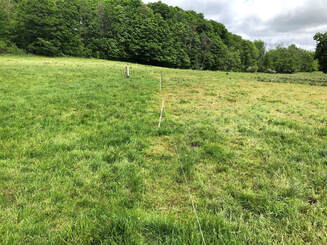CONSERVATION CORNER
A weekly blog for all things conservation
 Kevin Brown, BCCD, Ag Team Leader So, it is that time of year again. Time to let the animals out to pasture. No more feeding them stored forages that you had to make. No more catering to their every whim. Now, they can be let out and go take care of themselves. Well, at least for a short period of time. We like to say that we are “pasturing” our animals, but are we really? Yes, there are some that are, and do a really good job of it. However, opening the gate and letting them roam free on the same pasture for the next 6-7 months is not pasturing. That is an exercise lot. Yea, there may be some grass growing there originally, but unless you have an expansive pasture, that goes away fast. And even if you have a big enough lot that you don’t have to feed them any stored forages, you really aren’t doing the best thing for any of the resources you have. I will try to give you some information on some of the things going on with this style of “pasturing” that you may not know. It could make you a lot more money. First off, the smaller the plant, the higher the nutrition. How much does that animal really need? A mature animal does not need a lot. Having them graze 2-3” tall grass is just wasting a lot of the nutrients, and maybe cause problems. Too good of a diet can cause issues (founder in horses). Plants 3” tall are probably over 30% protein, and energy off the charts. That may be ok if they need it. Most do not.
Secondly, the energy reserves in grass are in the bottom 3” of the plant. If you keep the plant grazed down to less than 3”, it is doing everything it can to survive. Nothing else. (This goes for mowing lawns too). It will only yield maybe 1 ton/acre/year because it can’t take it. Not only are all the reserves in the bottom 3”, which you don’t have now, but there is no plant out there made to be grazed every day. REST is the single best thing you can do for a pasture. It needs to rest and recuperate, period. You could easily get 3-4 ton/acre just by leaving the bottom 3” and letting it rest for the recommended time. 3 more ton/acre x 10 acres x $150/ton = $4,500 in your pocket. Or, at least you don’t have to make as much for them. You could be fishing instead of making hay. Third, do you have grass that takes grazing well? Some do way better than others. Timothy is probably one of the worst grass species there is out there. It is low yielding, it hates hot weather, and it does not take grazing well. There are way better options out there- for grazing or haying. I can explain why if you want to give me a call. Fourth, it is being discovered that getting organic matter back to the soil to feed all the microbes is actually increasing forage yields substantially. When you harvest every last drop, no organic matter going back into the soil means nothing left to feed the microbes. Anyone who feeds a cow knows that you are really feeding the rumen, not the cow. That is the same for your crops. You feed the soil, and that feeds the crop. Lastly, and there are probably more things to think about, is that the roots below the ground are directly proportional to the growth above the ground. 2” above ground is 2” below ground. 12” above ground is 12” below ground. Which one do you think will produce better?
0 Comments
Leave a Reply. |
AuthorsVarious staff at the Bradford County Conservation District Archives
July 2024
Categories
All
|
|
Bradford County Conservation District
Stoll Natural Resource Center 200 Lake Road, Suite E | Towanda PA 18848 Phone: (570)-485-3144 |
